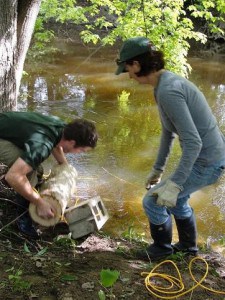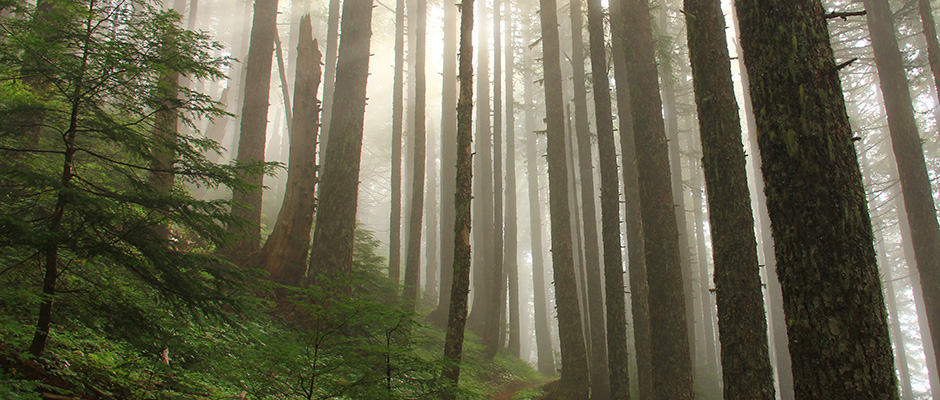Share this article
Preserving a Traditional Practice Kills Invasive Emerald Ash Borers
A traditional Native American basket-making practice can be helpful in killing an invasive insect that devastates forests and habitat for a wide range of wildlife, according to a newly published study.
The emerald ash borer (Agrilus planipennis) — an invasive beetle from Asia — was first discovered in North America in 2002 in Detroit, Mich. The insect species traveled along with imported goods from China inside wood packing material and started laying their eggs in nearby trees. While the insects may be small and a pretty green color, they infest all species of ash trees that wildlife such as birds feed on, including the black ash tree — a species Native Americans rely on for their traditional practice of basket making.

Tina Ciaramitaro, a U.S. Forest Service technician and Tom Baweja, a U.S. Forest Service biological aide toss logs into the Red Cedar River near Okemos, Mich. In a recent study, researchers found that by using a traditional Native American practice of submerging logs to preserve them for basket making, they can also kill invasive emerald ash borers.
Image Credit: Therese Poland, U.S. Forest Service
In a recent study published in the journal Agriculture and Forest Entomology, researchers with the U.S. Forest Service worked with members of the Match-e-be-nash-she-wish Band of Potawatomi Indians near Gun Lake, Mich. to test if the traditional practice of submerging black ash logs to preserve them for basket-making also kills emerald ash borers.
“Native tribes are concerned that ash trees are dying,” said Therese Poland, a research entomologist with U.S. Forest Service and the lead author of the study. “They wonder how they will continue their cultural tradition. We wanted to help them by using their traditional practices as a method to kill emerald ash borers.”
Traditionally, Native American basket weavers put the logs in fresh, running water, completely submerging them before using them to weave their baskets, in order to keep the logs from drying out and becoming too brittle to use. Using this practice, the researchers tested how long the logs had to be submerged before all of the emerald ash borers were killed, while still staying fresh for weaving baskets.
First, Poland and her team cut down logs of black ash trees that they knew were infested with emerald ash borers. They then created a control group of logs in which they determined the density of emerald ash borers inside of them when they weren’t submerged in water. The researchers tested different lengths of treatments by tying cinder blocks to the logs and submerging them in the Red Cedar River. After removing them from the water, they peeled and separated the wood to see if the quality was still good for basket making and to see how many adult emerald ash borers emerged from the wood.
“What we found was that submerging the logs does kill some of the larvae,” Poland said, adding that the larvae are the reason that the trees are destroyed. When adults lay eggs in the wood, the larvae then chew the thin layer inside the tree called phloem tissue that is responsible for transporting nutrients to the tree.
Poland said they found that in the winter, the logs had to be submerged for 18 weeks before all of the insects died, and it took 14 weeks in the spring. The insects are dormant in the winter, which may explain why it took them longer to become saturated and ultimately drown. After both 14 and 18 weeks, the wood remained creamy and white and ready to be used for weaving.
The team also left some of the logs submerged for 18 months and found that the all the emerald ash borers died. Although the outer ring of the wood became slightly rotted and crumbly, the inner rings remained usable for weaving. “You don’t have to submerge the wood that long [to kill the emerald ash borers], but the wood is still beautiful, fresh and has no odor if you do,” Poland said.
While Poland said this isn’t a long-term strategy for managing emerald ash borers, it will definitely help Native Americans preserve this traditional practice. “Emerald ash borers are going to stick around, and they are not going to be eradicated,” Poland said.
As for long-term management strategies, Poland said the U.S. Forest Service has some projects in the works. They are releasing parasitic wasps that kill emerald ash borer, using insecticides on trees and trying to breed ash trees that are resistant to the insects. “With these long-term strategies, we’re hoping to control emerald ash borers and to save ash trees,” she said.
Header Image: Image Credit: Bureau of Land Management








